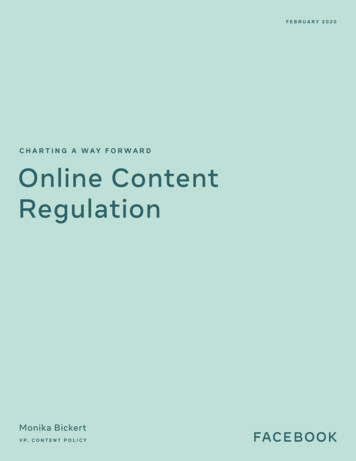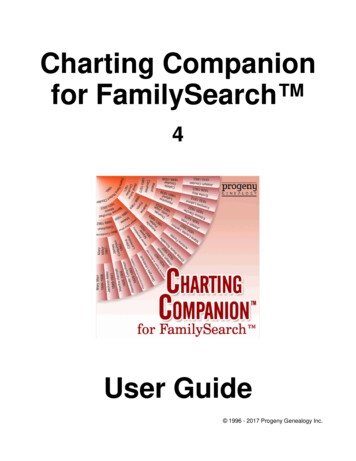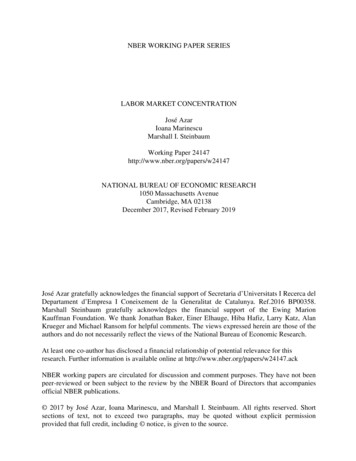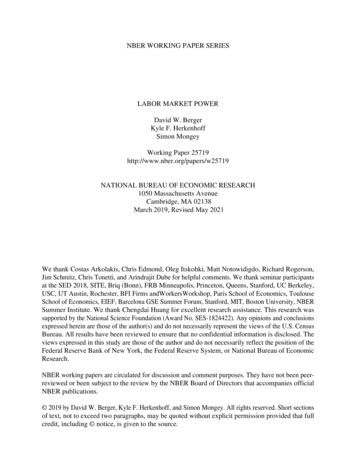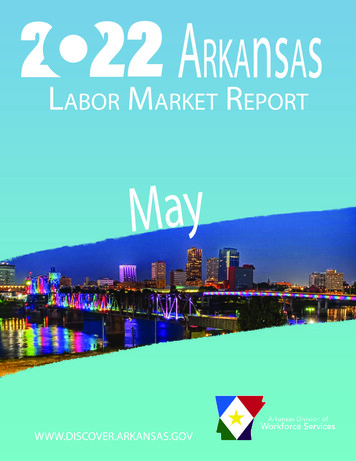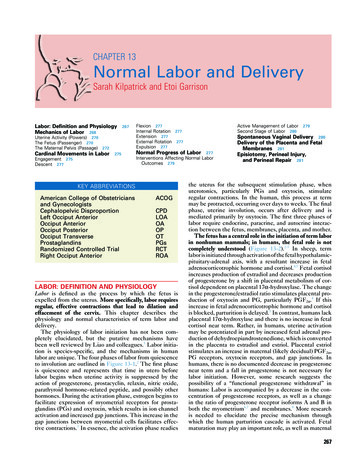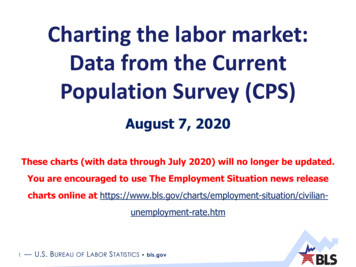
Transcription
Charting the labor market:Data from the CurrentPopulation Survey (CPS)August 7, 2020These charts (with data through July 2020) will no longer be updated.You are encouraged to use The Employment Situation news releasecharts online at vilianunemployment-rate.htm1— U.S. BUREAUOF LABORSTATISTICS bls.gov
Table of contents1.2.3.4.5.6.7.8.9.10.11.12.13.14.2Civilian labor forceCivilian labor force participation rateCivilian employmentEmployment-population ratioNonagricultural wage and salary employmentNonagricultural self-employed, unincorporatedPart-time workers as a percent of total employedEmployed part time for economic reasonsCivilian unemploymentCivilian unemployment rateDuration of unemploymentLong-term unemployed as a percent of total unemployedReasons for unemploymentJob losers by layoff status— U.S. BUREAUOF LABORSTATISTICS bls.gov
Table of contents—Continued15. Unemployment rates for adult men, adult women, and teenagers16. Unemployment rates by race and Hispanic or Latino ethnicity17. Unemployment rates for persons 25 years and older by educationalattainment18. Persons not in the labor force who want a job19. Persons not in the labor force, selected indicators20. Alternative measures of labor underutilizationAdditional information available in The Employment Situation news wse labor force concepts and data by subject:www.bls.gov/cps/cpsaz.htm3— U.S. BUREAUOF LABORSTATISTICS bls.gov
Chart 1. Civilian labor forceSeasonally adjusted, 1990–2020Numbers in 20,0001990 1992 1994 1996 1998 2000 2002 2004 2006 2008 2010 2012 2014 2016 2018 2020120,000Note: Shaded areas represent recessions as determined by the National Bureau of Economic Research (NBER). An endpointfor the recession that began in February 2020 has not yet been determined. Data online athttps://data.bls.gov/timeseries/LNS11000000.4— U.S. BUREAUOF LABORSTATISTICS bls.gov/cpsbls.gov
Chart 2. Civilian labor force participation rateSeasonally adjusted, 64.064.0July 202061.4 0162018Note: Shaded areas represent recessions as determined by the National Bureau of Economic Research (NBER). An endpointfor the recession that began in February 2020 has not yet been determined. Data online athttps://data.bls.gov/timeseries/LNS11300000.5— U.S. BUREAUOF LABORSTATISTICS bls.gov/cpsbls.gov2020
Chart 3. Civilian employmentSeasonally adjusted, 1990–2020Numbers in 15,0001990 1992 1994 1996 1998 2000 2002 2004 2006 2008 2010 2012 2014 2016 2018 2020115,000Note: Shaded areas represent recessions as determined by the National Bureau of Economic Research (NBER). An endpointfor the recession that began in February 2020 has not yet been determined. Data online athttps://data.bls.gov/timeseries/LNS12000000.6— U.S. BUREAUOF LABORSTATISTICS bls.gov/cpsbls.gov
Chart 4. Employment-population ratioSeasonally adjusted, 1990–2020Percent65.065.062.062.059.059.0July 202055.1 82000200220042006200820102012201420162018Note: Shaded areas represent recessions as determined by the National Bureau of Economic Research (NBER). An endpointfor the recession that began in February 2020 has not yet been determined. Data online athttps://data.bls.gov/timeseries/LNS12300000.7— U.S. BUREAUOF LABORSTATISTICS bls.gov/cpsbls.gov2020
Chart 5. Nonagricultural wage and salary employmentSeasonally adjusted, 1990–2020Numbers in 00,0001990 1992 1994 1996 1998 2000 2002 2004 2006 2008 2010 2012 2014 2016 2018 2020100,000Note: Shaded areas represent recessions as determined by the National Bureau of Economic Research (NBER). An endpointfor the recession that began in February 2020 has not yet been determined. Data online athttps://data.bls.gov/timeseries/LNS12032187.8— U.S. BUREAUOF LABORSTATISTICS bls.gov/cpsbls.gov
Chart 6. Nonagricultural self-employed, unincorporatedSeasonally adjusted, 1990–2020Numbers in 0008,5008,5008,0008,0007,5007,5007,0001990 1992 1994 1996 1998 2000 2002 2004 2006 2008 2010 2012 2014 2016 2018 20207,000Note: Shaded areas represent recessions as determined by the National Bureau of Economic Research (NBER). An endpointfor the recession that began in February 2020 has not yet been determined. Data online athttps://data.bls.gov/timeseries/LNS12032192.9— U.S. BUREAUOF LABORSTATISTICS bls.gov/cpsbls.gov
Chart 7. Part-time workers as a percent of totalemployedSeasonally adjusted, Note: Shaded areas represent recessions as determined by the National Bureau of Economic Research (NBER). An endpointfor the recession that began in February 2020 has not yet been determined. Beginning in 1994, data reflect the introductionof a major redesign of the Current Population Survey. Data online at https://data.bls.gov/timeseries/LNS12692153.10— U.S. BUREAUOF LABORSTATISTICS bls.gov/cpsbls.gov2020
Chart 8. Employed part time for economic reasonsSeasonally adjusted, 1990–2020Numbers in 4,0003,0003,0002,0002,0001,0001,00001990 1992 1994 1996 1998 2000 2002 2004 2006 2008 2010 2012 2014 2016 2018 2020Note: Shaded areas represent recessions as determined by the National Bureau of Economic Research (NBER). An endpointfor the recession that began in February 2020 has not yet been determined. Beginning in 1994, data reflect the introductionof a major redesign of the Current Population Survey. Data online at https://data.bls.gov/timeseries/LNS12032194.11— U.S. BUREAUOF LABORSTATISTICS bls.gov/cpsbls.gov0
Chart 9. Civilian unemploymentSeasonally adjusted, 1990–2020Numbers in 012,0008,0008,0004,0004,000001990 1992 1994 1996 1998 2000 2002 2004 2006 2008 2010 2012 2014 2016 2018 2020Note: Shaded areas represent recessions as determined by the National Bureau of Economic Research (NBER). An endpointfor the recession that began in February 2020 has not yet been determined. Data online � U.S. BUREAUOF LABORSTATISTICS bls.gov/cpsbls.gov
Chart 10. Civilian unemployment rateSeasonally adjusted, 11.010.09.08.07.06.05.04.03.02.01.00.0July 202010.2 2201420162018Note: Shaded areas represent recessions as determined by the National Bureau of Economic Research (NBER). An endpointfor the recession that began in February 2020 has not yet been determined. Data online � U.S. BUREAUOF LABORSTATISTICS bls.gov/cpsbls.gov2020
Chart 11. Duration of unemploymentSeasonally adjusted, 1990–2020Numbers in thousands15,00015,00012,00012,0009,0009,00015 to 26 weeks6,0005 to 14 weeksLess than 5 weeks3,0006,0003,00027 weeks and over001990 1992 1994 1996 1998 2000 2002 2004 2006 2008 2010 2012 2014 2016 2018 2020Note: Shaded areas represent recessions as determined by the National Bureau of Economic Research (NBER). An endpointfor the recession that began in February 2020 has not yet been determined. Data online es id LNS13008756&series id LNS13008876&series id LNS13008636.14— U.S. BUREAUOF LABORSTATISTICS bls.gov/cpsbls.gov
Chart 12. Long-term unemployed as a percent of totalunemployedSeasonally adjusted, ent unemployed 27weeks and 20102012201420162018Note: Shaded areas represent recessions as determined by the National Bureau of Economic Research (NBER). An endpointfor the recession that began in February 2020 has not yet been determined. Data online � U.S. BUREAUOF LABORSTATISTICS bls.gov/cpsbls.gov2020
Chart 13. Reasons for unemploymentSeasonally adjusted, 1990–2020Numbers in 016,00014,000Job 0Reentrants4,0002,000Job leaversNew entrants6,0004,0002,000001990 1992 1994 1996 1998 2000 2002 2004 2006 2008 2010 2012 2014 2016 2018 2020Note: Shaded areas represent recessions as determined by the National Bureau of Economic Research (NBER). An endpointfor the recession that began in February 2020 has not yet been determined. Data online es id LNS13023705&series id LNS13023557&series id LNS13023569.16— U.S. BUREAUOF LABORSTATISTICS bls.gov/cpsbls.gov
Chart 14. Job losers by layoff statusSeasonally adjusted, 1990–2020Numbers in 014,00012,000On temporary layoff12,00010,00010,0008,0008,000Not on 0 1992 1994 1996 1998 2000 2002 2004 2006 2008 2010 2012 2014 2016 2018 2020Note: Shaded areas represent recessions as determined by the National Bureau of Economic Research (NBER). An endpointfor the recession that began in February 2020 has not yet been determined. Data online es id LNS13023653.17— U.S. BUREAUOF LABORSTATISTICS bls.gov/cpsbls.gov
Chart 15. Unemployment rates for adult men, adultwomen, and teenagersSeasonally adjusted, 1990–2020Percent35.035.030.030.025.0Teenagers, 19.3%(16 to 19 years)20.0Adult women,10.5%(20 years and over)15.0Adult men, 9.4%(20 years and over)10.05.025.020.015.010.05.00.00.01990 1992 1994 1996 1998 2000 2002 2004 2006 2008 2010 2012 2014 2016 2018 2020Note: Shaded areas represent recessions as determined by the National Bureau of Economic Research (NBER). An endpointfor the recession that began in February 2020 has not yet been determined. Data online es id LNS14000026&series id LNS14000012.18— U.S. BUREAUOF LABORSTATISTICS bls.gov/cpsbls.gov
Chart 16. Unemployment rates by race and Hispanic orLatino ethnicitySeasonally adjusted, ks or AfricanAmericans, 14.6%14.0Hispanicsor tes,9.2%Asians,12.0%4.02.00.00.01990 1992 1994 1996 1998 2000 2002 2004 2006 2008 2010 2012 2014 2016 2018 2020Note: Shaded areas represent recessions as determined by the National Bureau of Economic Research (NBER). An endpointfor the recession that began in February 2020 has not yet been determined. Persons of Hispanic or Latino ethnicity may be ofany race. Seasonally adjusted data for Asians are not available before 2003. Data online es id LNS14000006&series id LNS14032183&series id LNS14000009.19— U.S. BUREAUOF LABORSTATISTICS bls.gov/cpsbls.gov
Chart 17. Unemployment rates for persons 25 years andolder by educational attainmentSeasonally adjusted, 1992–2020Percent22.022.020.020.018.016.014.0High school graduates,no college, 10.8%Some collegeor associatedegree, 10.0%12.010.018.0Less than a highschool 0.019922.0Bachelor’s degree and higher, 162018Note: Shaded areas represent recessions as determined by the National Bureau of Economic Research (NBER). An endpointfor the recession that began in February 2020 has not yet been determined. Data online es id LNS14027660&series id LNS14027689&series id LNS14027662.20— U.S. BUREAUOF LABORSTATISTICS bls.gov/cpsbls.gov20200.0
Chart 18. Persons not in the labor force who want a jobSeasonally adjusted, 1994–2020Numbers in 006200820102012201420162018Note: Shaded areas represent recessions as determined by the National Bureau of Economic Research (NBER). An endpointfor the recession that began in February 2020 has not yet been determined. Data online � U.S. BUREAUOF LABORSTATISTICS bls.gov/cpsbls.gov2020
Chart 19. Persons not in the labor force, selected indicatorsSeasonally adjusted, 1994–2020Numbers in thousands3,0003,0002,5002,500Marginally 420162018Note: Shaded areas represent recessions as determined by the National Bureau of Economic Research (NBER). An endpointfor the recession that began in February 2020 has not yet been determined. Data online es id LNS15026645.22— U.S. BUREAUOF LABORSTATISTICS bls.gov/cpsbls.gov2020
Chart 20. Alternative measures of labor underutilizationSeasonally adjusted, 5U-4U-3U-2U-6U-5U-44.012.08.0U-1U-2U-3Unemployment 0820102012201420162018Note: Shaded areas represent recessions as determined by the National Bureau of Economic Research (NBER). An endpointfor the recession that began in February 2020 has not yet been determined. Data online es id LNS14023621&series id LNS14000000&series id LNS13327707and at https://data.bls.gov/timeseries/LNS13327708&series id LNS13327709.bls.gov.23 — U.S. B UREAU OF LABOR S TATISTICS bls.gov/cps2020
1. Civilian labor force 2. Civilian labor force participation rate 3. Civilian employment 4. Employment-population ratio 5. Nonagricultural wage and salary employment 6. Nonagricultural self-employed, unincorporated 7. Part-time workers as a percent of total employed 8. Employed part time for economic reasons 9. Civilian unemployment 10 .


